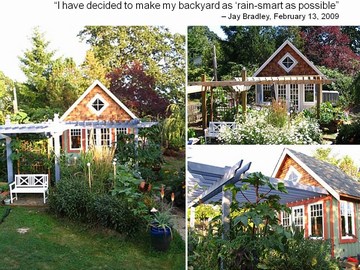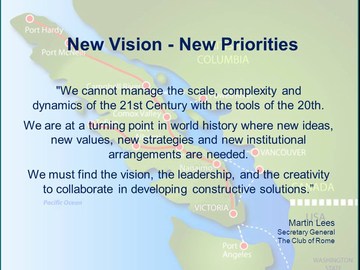
Convening for Action on Vancouver Island
The Irrigation Industry Association of British Columbia held its 2010 Annual Convention in Victoria in November 2010. Jay Bradley, Chair of the Vancouver Island Coordinating Team, was invited to inform the irrigation audience by addressing this question: What is CAVI and what are its goals?
CAVI is the acronym for Convening for Action on Vancouver Island – Leadership in Water Sustainability. CAVI is an inclusive partnership, reaching out to audiences that share a vision of achieving water sustainability on Vancouver Island. CAVI is committed to achieving settlement change in balance with ecology, beginning with water-centric planning.
About the presentation
“It was a 30 minute 'high level' power point presentation on what and who CAVI is, how it was formed, what we've been up to and where we intend to go,” explains Jay Bradley.
 “Suffice it to say, the presentation was peppered to highlight the various principles we are advocating, from 'green value' to 'design with nature', from the 'Regional Team Approach' to the '50-year vision' for Vancouver Island.”
“Suffice it to say, the presentation was peppered to highlight the various principles we are advocating, from 'green value' to 'design with nature', from the 'Regional Team Approach' to the '50-year vision' for Vancouver Island.”
“As it turned out, this was the first time the attendees had heard about CAVI, mainly because many of those in atttendance were from the mainland. So it seemed to pique a lot of interest and curiosity.”
What do we want this place to look like?
“A big part of what Convening for Action does is to create forums for dialogue, and to build collaborative partnerships towards a 50 year vision for Vancouver Island. Our message to the IIABC was very high level but highly effective – what do we want Vancouver Island to look like in 50 years?,” continues Jay Bradley.
“I believe this message really resonated with the session participants, especially when it was framed by how quickly the island has grown in the past 20 years, as well as how we want to pass the island on to future generations.”
“As practitioners, irrigation specialists are among the experts who do not need to be convinced of the importance of water. Forums like this not only help to break down the silo mentality but also emphasise the new land ethic: a water-centric, design-with-nature approach to land development.”
Walking the Talk
When it comes to reducing one’s hydrologic footprint, Jay is 'walking the talk'. He has decided to make his own yard as “rain-smart” as possible,” not only to be ecologically-sensitive but to demonstrate and teach what can be done by the average home-owner to maintain rain water quality and manage run-off. He has installed rain garden and infiltration galleries, living ‘green’ walls and is getting started on a green roof.

To Learn More
To download a PDF copy of Jay Bradley's presentation, click on Water for Life & Livelihoods: The CAVI Model
To download a PDF copy of the brochure published by CAVI, click here.
To read about how Jay Bradley is 'walking the talk', click on Chair of Vancouver Island Coordinating Team reduces his 'hydrological footprint'
About Jay Bradley:
Jay Bradley was born and raised in Port Alberni, B.C. A proud Vancouver Islander, he can trace his family back to pioneer miners who came to Nanaimo in 1854.
Jay earned a Bachelor of Science in Geography from the University of Victoria. Before that he was employed in a variety of capacities, including resource planning in the Northwest Territories, regional planning in the Regional District of Alberni-Clayoquot, and teaching in Japan. After graduation, he was hired by the City of Nanaimo and worked in the Planning and Development Department. He was appointed as a Subdivision Approving Officer in 1994.
In 2001 Jay left Nanaimo to settle in Victoria, where he has worked for a number of jurisdictions as a planner and Approving Officer. He was responsible for preparing progressive “performance-based” bylaws to address rainwater management, and in 2004 he was invited to join the Inter-Governmental Partnership for the Water Balance Model.
In 2006, Jay helped initiate the Vancouver Island Coordinating Team (VICT) and became a member of the CAVI leadership team to advocate for water sustainability on Vancouver Island. In the same year, he moved to the Ministry of Agriculture and Lands as a land policy analyst, and is now with the Ministry of Forests, Lands and Mines as a Senior Legislative Analyst.

Posted December 2010